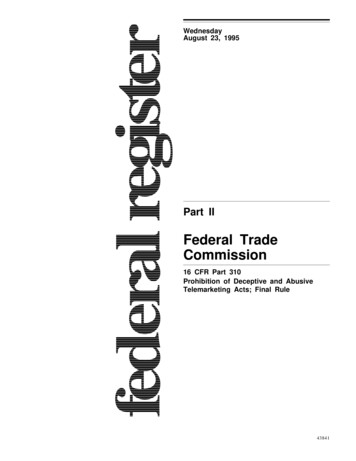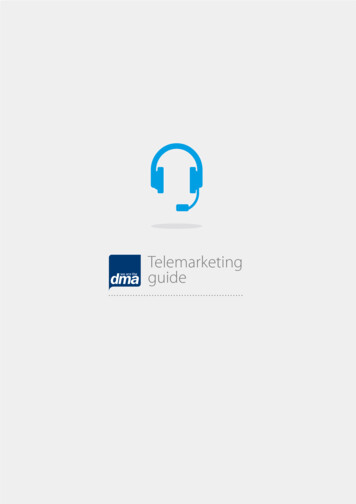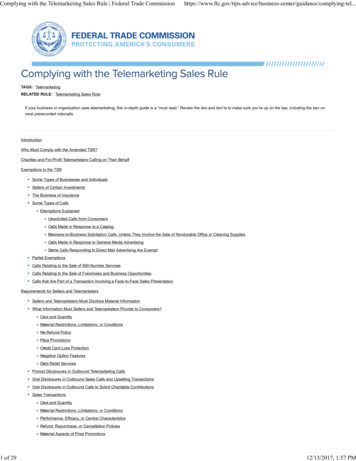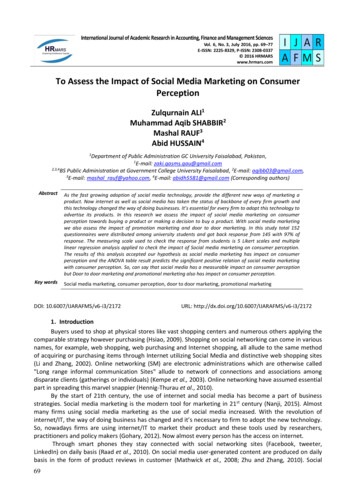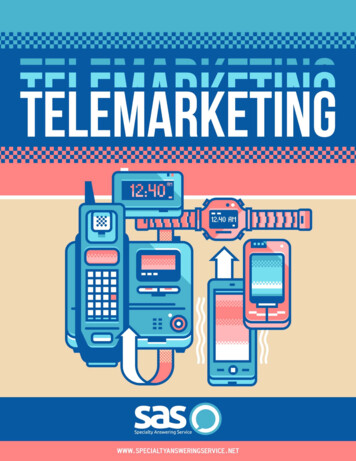
Transcription
0 Specialty Answering Service. All rights reserved.
Contents1Introduction22Telemarketing Trends22.1Location - Offshore vs. Nearshore vs. Onshore22.2Brick and Mortar Vs. At Home32.3Outbound Vs. Blended Vs. Mixed33Telemarketing Business Practices33.1List Management33.2Telemarketing Applications33.3Telemarketing Challenges44KPIs44.1Call Metrics44.2Outbound Time Metrics54.3Outbound Telemarketing Metrics55Best Practices in Telemarketing56Choosing a Telemarketing rn on Investment76.5Telemarketing Costs86.6Quality Assurance86.6.1Shadow Monitoring86.6.2Hosted Monitoring86.6.3Sales Verification8Monitoring and Reporting96.76.7.1Daily reports96.7.2Monthly Reports96.7.3End of Term Reports97Conclusion98References10
1 IntroductionOutbound contact centers are mainly used for three types of applications – customer service,telemarketing (sales) and collections. The role of an outbound contact center is no longer restricted tolead generation or sales. Outbound contact centers have become an integral channel for deliveringcustomer service. Companies use outbound contact centers for winning back customers, reduce customerchurn, welcome new customers into the company’s fold and to explain the services being offered. Theycan also be used for cross-selling to existing customers, conduct customer satisfaction surveys and even todetect customer frauds. There are two types of dialing that are used in a contact center – manual dialingand predictive dialing. Predictive dialers are far more efficient when it comes to contact rates and a goodpredictive dialer can offer as high as 200%-300% increase in contact rate. Today most telemarketingcontact centers use predictive dialers as they reduce the administrative overheads and allow agents tothen focus on conversion rates.In this paper we will mainly focus on telemarketing. Within the telemarketing umbrella there can bedifferent kinds of outbound calls that happen. These include cold calls for telesales, lead follow-up basedon customer interest shown through another channel such as a website, fund-raising efforts, marketresearch activities that aid in identifying customer preferences, and proactive notification of deals andoffers.2 Telemarketing TrendsIn the United States itself there are more than 5,000 telemarketing centers which vary in size and serviceofferings. Most of the telemarketing business is however concentrated within the largest 50 contactcenters. The rest of the companies are mostly small operations with just 20-50 seats which are nottechnologically intensive and run small time programs for sectors which do not require stringentregulatory compliance. Typically most companies use multiple telemarketing vendors to ensure a healthycompetition among vendors for their campaign success and also to reduce their dependency on a singlevendor. Agent quality is also an important factor for telemarketing success. Telemarketing contact centerscan be classified in various ways as below:2.1 Location - Offshore vs. Nearshore vs. OnshoreDepending on the location of the contact center handling telemarketing in relation to the company whosecampaign is being run, they can be classified into offshore, nearshore or onshore telemarketing centers.Offshore telemarketing centers are usually located in a different continent – primarily Asia. Nearshoretelemarketing centers are mostly located in countries close to the United States such as Mexico and Brazil.However, the biggest success for telemarketing campaigns has been with the use of onshore agents –where contact centers located in America and employing American agents handle the campaigns. It avoidsproblems such as accent differences and cultural differences which can cause havoc in the sales process.Thus, while offshoring has been popular for inbound contact centers, telemarketing initiatives has beenbetter handled by onshore agents.
2.2 Brick and Mortar Vs. At HomeA major trend in the telemarketing business today is the use of home agents. The risk however is thatagent development, training and quality may be significantly affected in this model. Unlike in an inboundcontact center where home agents can be used effectively to handle demand peaks, an untrained agentmay directly affect the sales productivity when used for telemarketing.2.3 Outbound Vs. Blended Vs. MixedWhile some contact centers have agents who handle both inbound and outbound calls, it is best to havededicated agents to handle outbound telemarketing initiatives. This is because the skill sets required for asuccessful telemarketing agent are very different from that required for an inbound agent. Atelemarketing agent should have the ability to convince a potential buyer about the benefits of a newproduct or service offering and also have the capability to close a sale. An inbound agent, on the otherhand, need to only be able to follow a defined process to handle the service request from the caller.3 Telemarketing Business Practices3.1 List ManagementMaintaining the list of prospects is a key step in the telemarketing process. The initial list building startswith acquiring a generic list of phone numbers. Qualifying calls are made to these numbers to eliminatefax numbers, disconnected numbers, etc., and also those prospects who do not show any interest in theproduct. After this, the initial telemarketing database is ready. List scrubbing refers to the periodic processof maintaining and updating the database based on call outputs and other information.3.2 Telemarketing ApplicationsTelemarketing may be used for various business needs. Some of these are listed below:1. Mailer Follow-Up : Telemarketing may be used as a follow-up mechanism post a mass mailingexercise2. Surveys : Telemarketing may be used to conduct surveys such as customer satisfaction surveys orcustomer preference surveys.3. Account Activation : These are also known as welcome calls where a new customer is welcomedand briefed on how the service/product works. These calls also act as a platform for the customerto clarify any initial doubts that he may have.4. Dormant Account Reactivation : For products such as stock brokerage services or credit cards,where the revenue is dependent on how often the customer uses the product, telemarketing maybe used for dormant account reactivation. The telemarketing agent probes the customer on whyhe hasn’t been using the service and attempts to re-engage with him.5. Account Winbacks : Studies have shown that if a company engages with a customer within 14 daysof losing him, there is a 70% chance of winning them back. Account winback programs are aimedat bringing back customers who have stopped using a service or a product back into thecompany’s fold.
6. Account renewals : Telemarketing programs can also be designed for proactive renewals ofservices such as cellular contracts, insurance policies etc before they actually expire and thecustomer is likely to compare competitive offers.7. Cross-sales and Up-sales : Telemarketing can effectively help companies in cross sales and upsales. Typical examples include increase in credit limits, offering cell phone insurance and so on.3.3 Telemarketing ChallengesThere are several challenges in running a telemarketing program. The list quality is an importantparameter for telemarketing success. Often the list provided by the company may be substandard orirrelevant to the product to be sold and the telemarketing center takes the blame for the failure of theprogram. Some of the key things that a telemarketing center needs to focus on include identifying themost desirable accounts, prioritizing which accounts to target first, how to achieve maximum listpenetration and how to evaluate and improve conversion rates.4 KPIsSince telemarketing is a form of sales campaign, it is essential to monitor and measure the results on aperiodic basis in order to be able to tweak the campaign so as to gain maximum benefits and ensurecampaign success. Since telemarketing is often done through a contact center there are three types ofmetrics that are normally tracked which are discussed below:4.1 Call MetricsCall metrics typically deal with the effectiveness of the dialer technology being used as well as the list thatis being used. Typically predictive dialers improve call metrics when compared to manual dialing by agents.Also, a well-qualified list will minimize call abandon rates and improve right party contacts. Some of thekey metrics that are tracked include the dials per hour, connects per hour, connect rate (which is the ratioof connects per hour to dials per hour), abandon rate, and right party connect (RPC) rate.Good dialer technology can improve dials per hour by filtering out a lot of calls that waste agents dialingtime such as fax signals, disconnected numbers and even busy tones. Ideally a telemarketing list should bedropped after a 75% penetration as it has been shown that the performance (positive response) dropsafter this. This does not mean that 25% of the records were not called. Rather, the 75% refers to thepercentage of instances where some response was obtained or the maximum attempts to contact weremade (typically 7-10 times). The penetration rates after which a list is dropped also depends on therevenue model for the particular campaign. If the payment is made on a pay per performance metric, thenthe telemarketing contact centre may choose to use the list only till such time that the response rate is ata profitable level.The connects per hour will be higher for a B2C campaign where the time taken per call is less whencompared to a B2B program which typically take longer as agents have to speak to secretaries or passthrough an IVR system or dial an extension number, before reaching the target customer/ decision maker.
All these activities take time, albeit a few seconds per call. In a B2B campaign the connects per hour isabout 6-8 whereas for a B2C campaign it can be as high as 12-14 per hour.4.2 Outbound Time MetricsThe other key set of metrics that are measured in telemarketing involves those related to the timeinvolved in various activities (which can be classified as productive and non-productive). These include a.talk time which is the amount spent by the agent in actually talking to the prospect, b. the update timewhich is the time taken by the agent to update the details regarding the call outcome in the system, c. thetotal handling time which is the sum of the talk time and the update time d. the agent idle time which isthe time between calls when the agent is idle.A telemarketing campaign shall aim at minimizing the update time and the idle time as these arenon-productive activities.4.3 Outbound Telemarketing MetricsThe third set of metrics that a telemarketing campaign needs to monitor closely is directly related to salesachieved. Some of the common metrics in this bucket include the sale per hour, the conversion rate (theratio of sales to the no. of prospects contacted), the total sales revenue, the average sale amount per calland the total products sold (in case of a campaign for multiple products).5 Best Practices in TelemarketingIn this section we will look at some of the best practices to be followed for telemarketing success.1. Increase the number of calls : Assuming conversion rate to be a constant, the higher the numberof calls an agent can make the better the sales metrics will be. An automated predictive dialer is amust have for telemarketing success in today’s competitive landscape. It is also important to havea prospect database that is up to date and refreshed periodically.2. Remove non-value adding activities : In order to improve the success of a telemarketing initiative,it is necessary that the non-value adding activities performed by an agent such as dial time, holdtime, update time etc are minimized. This can be done effectively using an intelligent predictivedialer. It is also necessary to improve the agent’s productivity using tools such as CRM which willprovide necessary information about the prospect’s history for the agent to make a strong salespitch.3. Personalize and Customize the Service offering : It is also necessary to use data analytics of theprospect’s previous history with the Company, if any to personalize and customize the serviceoffering so as to increase the chances of a successful sale. It is necessary to maintain a database ofcustomer preferences, previous customer interactions with the various channels (website, socialmedia, contact center) and past purchase behavior of the customer.
4. Invest in Coaching and Training : Lastly, the well known adage of ‘people buy from people’ isapplicable in the case of telemarketing as well. It is important to monitor how agents conductthemselves during a call. Recording good and bad calls and incorporating them in the training planwill help improve agent performance and consequently sales closure rates. QA scoring modelsshould be developed and tracked at an individual agent level as well as at a team level.6 Choosing a Telemarketing PartnerIn this section we will cover some of the factors to be considered when choosing a telemarketing center .6.1 AgentsThe quality of the agents and the investments that the contact center makes to train their agents andequip them with the right skills are important parameters to consider while choosing a telemarketingcenter. The profile of telemarketing agents can vary widely between that of a youngster’s first job, to ahousewife looking for additional income or a retired person trying to kill his boredom. It is important toknow where the agent pool comes from and how the contact center classifies them and trains them.While some contact centers track and monitor agents based on demographics others use agent maturity(amount of time agent has spent with the contact center) as the basis for classification. Attrition rates area good indicator of how good the agent pool in the telemarketing center is and how well the contactcenter is treating them (which in turn will affect their performance). Typically, a contact center with anagent turnover of less than 20% is doing an excellent job of hiring and training their agents to besuccessful in their work.Some telemarketing contact centers, in an attempt to save costs, have minimal training budgets whereagents are trained to a minimum level and then put on the job, expecting him to perform. The assumptionhere is that the good agents will perform by themselves and the rest will leave in due course, thus helpingsave money. This cost savings are then passed on to the client as reduced billings. On the other hand, goodtelemarketing centers are willing to invest in in-depth training and agent development skills thus enablingthe agents to perform at a higher level of efficiency. The cost per hour for such contact centers may behigh, however, the overall sales improvement that these centers offer more than make up the additionalcosts for the client. From the telemarketing contact center’s perspective as well this is better as the agentswill have better product knowledge and customer handling skills which will enhance the brand image ofboth the client and the contact center. Good training will not only improve sales force performance, butalso reduce agent churn.6.2 TechnologyAnother major consideration while deciding between an in-house telemarketing campaign vs. outsourcingit to a contact center is the cost of the technology involved. Apart from standard contact centertechnology systems and infrastructure, the key investment for telemarketing is a dialing system. A gooddialing system can contribute significantly to the success of a telemarketing campaign by making callsmore efficient and effective. Most dialing systems have two standard settings – predictive and preview.Predictive dialers use algorithms to predict which number to dial and transfers the calls to the agent only
when a person answers the call. These systems have the ability to filter out fax numbers, answeringmachines and disconnected numbers, thus increasing the number of live calls that agents handle. Thedialer systems are able to call more numbers than a manual dialing operation by agents using algorithmsthat take into consideration average call times, connects and other such factors. Some of these dialers canwork through a list in one day when manual dialing will take upto a week. This is what makestelemarketing far more effective than having an in-house sales team make phone calls to prospects.Data handling is another major aspect in telemarketing. Both incoming and outgoing data is key tocompanies and it is important to partner with a telemarketing company that has the capability to handledata accurately, effectively and in a secure manner. Ideally, the telemarketing center should have in itsrolls a set of programmers and data analysts who can handle the data in a proper manner. This is a keyand often overlooked aspect while selecting a telemarketing company. The data files of the client wouldtypically contain proprietary information about customers, prospects and the product that is being sold aswell as any offers or deals that are available. An ability to handle this information in the most effectivemanner from day one is critical to make the campaign a complete success.Security is another major concern while choosing a telemarketing center. While most centers will havesome level of security systems built in into their network architecture, it is important to verify whetherthey comply with all local and sector specific regulations such as PCI DSS (Payment Card Industry DataSecurity Standards). A good telemarketing center will also have a robust disaster recovery and businesscontinuity plan.6.3 TestingJust as in the case of any direct marketing initiative, testing is a key step in telemarketing as well. When atelemarketing campaign is initially rolled out, it may not be an overwhelming success. The goal should beto achieve realistic targets that can be improved over time. It is also important to give sufficient time forthe telemarketing campaign to run (at least a month) before deciding whether it is a success or failure.Various factors such as the call script, the target segment etc can be changed to verify whether the resultsare likely to improve.6.4 Return on InvestmentROI is an important consideration while planning a telemarketing program. Depending upon how well atelemarketing campaign is planned, it can turn out to be the most expensive marketing effort of thecompany or the most profitable. The best way to measure the ROI of a telemarketing program is tocalculate the conversion rates and sales per hour metrics that should be achieved to make the programfeasible. Based on this, the breakeven point – the cost per sale that can make the program profitable canbe arrived at. In some cases, it may be a good idea to offer a lower price to onboard the customer, hopingfor future revenues from the customer. This is true for industries where customer acquisition is difficult,but customer switching costs are high.
While the telemarketing center will try its best to make the program a success, it is important for thecompany to define what success looks like and to enable the telemarketing center with the rightinformation to achieve this.6.5 Telemarketing CostsMany clients are unable to effectively estimate the costs involved in a telemarketing campaign. As a result,they often make the mistake of hiring a couple of people in-house to make manual sales calls. In realitythese efforts often do not generate the kind of profitable results that a targeted telemarketing programrun by a specialized contact center can provide. Some of the key costs that are involved in a telemarketingcampaign are discussed below.Cost per call: Using a standard telephone and PC infrastructure, a single agent can at best make around 70calls in a day. Some people may claim to have made as many as 200 calls in a day, but in such casesinvariably the call results and post call documentation suffers negatively.Infrastructure costs: A successful telemarketing program requires much more than just a PC and astandard telephone. Hardware equipment and software such as predictive dialers, CRM software anddatabase tools all contribute to the costs of a telemarketing campaign.People Costs: Good agents are the backbone of a telemarketing campaign. People costs include trainingcosts in addition to salary costs.6.6 Quality AssuranceOne of the most important factors in the overall success of any telemarketing program is the qualityassurance efforts that are placed on the program. Quality assurance ensures that the client’s overall brandimage is protected through periodic monitoring and reporting of calls. One key element of a good qualityassurance process in telemarketing is sales verification where every sale is verified before the customer isbilled for something that they possibly never ordered.6.6.1Shadow MonitoringMost telemarketing centers have silent monitoring or shadow monitoring capabilities that allow clients tolisten any time into the calls being made as they are confident about the quality of services that they offer.This also acts as a checkpoint for the client to ensure that the metrics and agent skills that thetelemarketing center claims to offer is actually available, and also to verify whether the scripts andverbiage being provided by the client is being used.6.6.2 Hosted MonitoringIn a hosted monitoring scenario, every call is listened live by a client representative. Here, the client andtelemarketing center works as a joint collaborative team to improve the overall program strategy. This is akey aspect in the testing stage of the program where the scripts and verbiage are being finalized.6.6.3Sales Verification
Sales verification is typically done by an independent quality assurance person who will confirm the saleswith the customer prior to raising the invoice. This will increase customer satisfaction and overall paymentrates.6.7 Monitoring and ReportingOne key differentiator between direct marketing initiatives such as mailers and telemarketing is thattelemarketing captures the customer feedback directly from their mouths. Often when a sales pitch isunsuccessful, valuable insights can be obtained on the reasons behind why the customer is not buying aproduct or service. This information, if captured effectively can help to improve the product offering andthus improve long term sales. Although this is just a byproduct of the telemarketing program, it is valuableinformation for the business. A good telemarketing center will offer reports at periodic intervals.6.7.1 Daily reportsDaily reports offer a snapshot of the previous day’s calling efforts. These reports are helpful to analyze at amicro level as to what is happening on a day to day basis and make quick improvements to the program.6.7.2 Monthly ReportsMonthly reports are more detailed reports that cover key metrics and call results for an entire month.They will be similar to daily reports, but span a longer period of time and hence can offer more insightsinto what is working well and what needs to be changed. For example, based on the metrics, thetelemarketing center can decide whether the list needs to be improved or which agents need moretraining and hand holding. It will also help to monitor how different scripts can impact differentdemographic profiles in the list.6.7.3 End of Term ReportsEnd of term reports essentially capture the end result of the program. These reports help thetelemarketing center to demonstrate that they have delivered what they promised at the start of theprogram. It will also point out deficiencies of the program. Analyzing these reports will also offer insightson what demographic profile is most likely to buy the products, which time is best suited to achieve themaximum conversion rates and so on. It will also indicate which offers are most interesting for potentialcustomers . These reports should form a key input while designing the next telemarketing program. Theseshould also be shared with the client’s product team so that they can incorporate customer feedback intothe next product offering.7 ConclusionTelemarketing has evolved considerably in the past decade, but the fundamentals still remain the same. Itis important to understand the whole telemarketing process in order for contact centers to be able togarner clients for this business and to enable ongoing success. Unlike other services, in the case oftelemarketing, the contact center is a direct marketing partner for the business and not just a vendor. As aresult, the contact center will have to show the same commitment to the telemarketing program andmonitor and measure it closely to enable a successful campaign.
8 References1. Whitepaper on Understanding Telemarketing – Mark Swanson2. www.altitude.com3. ‘How to Make an Effective Outbound Call Center’ – Avaya Communications
Telemarketing may be used for various business needs. Some of these are listed below: 1. Ma i l e r F o l l o w- U p : Telemarketing may be used as a follow-up mechanism post a mass mailing exercise 2. S u r v e y s : Telemarketing may be used to conduct surveys such as customer satisfaction surveys or customer preference surveys. 3.




